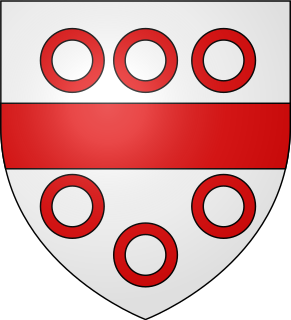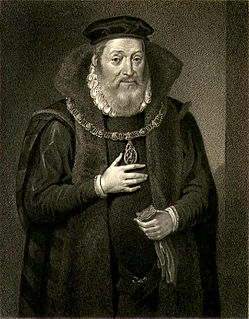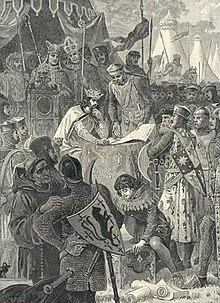The peerages in the United Kingdom are a legal system comprising both hereditary and lifetime titles, composed of various noble ranks, and forming a constituent part of the British honours system. The term peerage can be used both collectively to refer to the entire body of nobles, and individually to refer to a specific title. British peerage title holders are termed peers of the Realm. The peerage's fundamental roles are ones of government, peers being eligible to a seat in the House of Lords, and of meritocracy, the receiving of any peerage being the highest of British honours. In the UK, five peerages or peerage divisions co-exist, namely:

Baron is a rank of nobility or title of honour, often hereditary, in various European countries, either current or historical. The female equivalent is baroness. Typically, the title denotes an aristocrat who ranks higher than a lord or knight, but lower than a viscount or count. Often, barons hold their fief – their lands and income – directly from the monarch. Barons are less often the vassals of other nobles. In many kingdoms, they were entitled to wear a smaller form of a crown called a coronet.
The Peerage of Ireland consists of those titles of nobility created by the English monarchs in their capacity as Lord or King of Ireland, or later by monarchs of the United Kingdom of Great Britain and Ireland. It is one of the five divisions of Peerages in the United Kingdom. The creation of such titles came to an end in the 19th century. The ranks of the Irish peerage are duke, marquess, earl, viscount and baron. As of 2016, there were 135 titles in the Peerage of Ireland extant: two dukedoms, ten marquessates, 43 earldoms, 28 viscountcies, and 52 baronies. The Crown of the United Kingdom of Great Britain and Northern Ireland continues to exercise jurisdiction over the Peerage of Ireland, including those peers whose titles derive from places located in what is now the Republic of Ireland. Article 40.2 of the Constitution of Ireland forbids the state conferring titles of nobility and an Irish citizen may not accept titles of nobility or honour except with the prior approval of the Irish government. This issue has not arisen in respect of the Peerage of Ireland because no creation of titles in it has been made since the constitution came into force.
Forms of address used in the United Kingdom are given below.
The Peerage of Scotland is one the five divisions of peerages in the United Kingdom and for those peers created by the King of Scots before 1707. Following that year's Treaty of Union, the Kingdom of Scots and the Kingdom of England were combined under the name of Great Britain, and a new Peerage of Great Britain was introduced in which subsequent titles were created.
The Peerage of England comprises all peerages created in the Kingdom of England before the Act of Union in 1707. In that year, the Peerages of England and Scotland were replaced by one Peerage of Great Britain. There are five peerages in the United Kingdom in total.

Earl of March is a title that has been created several times in the Peerage of Scotland and the Peerage of England. The title derived from the "marches" or borderlands between England and either Wales or Scotland, and it was held by several great feudal families which owned lands in those districts. Later, however, the title came to be granted as an honorary dignity, and ceased to carry any associated power in the marches.

Baron Lucas is a title that has been created twice in the Peerage of England. The second creation is extant and is currently held with the title Lord Dingwall in the Peerage of Scotland.
The hereditary peers form part of the peerage in the United Kingdom. As of September 2022, there are 808 hereditary peers: 29 dukes, 34 marquesses, 191 earls, 111 viscounts, and 443 barons.
The history of the British peerage, a system of nobility found in the United Kingdom, stretches over the last thousand years. The current form of the British peerage has been a process of development. While the ranks of baron and earl predate the British peerage itself, the ranks of duke and marquess were introduced to England in the 14th century. The rank of viscount came later, in the mid-15th century. Peers were summoned to Parliament, forming the House of Lords.
The title Earl of Holderness also known as Holdernesse existed in the late 11th and early 12th centuries as a feudal lordship and was officially created three times in the Peerage of England namely in 1621, in 1644 as a subsidiary title to that of the then-Duke of Cumberland and in 1682. The official creations lasted 5, 38 and 96 years respectively.

In Scotland, a baron is the head of a feudal barony, also known as a prescriptive barony. This used to be attached to a particular piece of land on which was situated the caput or essence of the barony, normally a building, such as a castle or manor house. Accordingly, the owner of the piece of land containing the caput was called a baron. According to Grant, there were around 350 identifiable local baronies in Scotland by the early fifteenth century and these could mostly be mapped against local parish boundaries. The term baron was in general use from the thirteenth century to describe what would have been known in England as a knight of the shire.

A feudal baron is a vassal holding a heritable fief called a barony, comprising a specific portion of land, granted by an overlord in return for allegiance and service. Following the end of European feudalism, feudal baronies have largely been superseded by baronies held as a rank of nobility, without any attachment to a fief. However, in Scotland, the feudal dignity of baron remains in existence, and may be bought and sold independently of the land to which it was formerly attached.
The British nobility is made up of the peerage and the (landed) gentry. The nobility of its four constituent home nations has played a major role in shaping the history of the country, although now they retain only the rights to stand for election to the House of Lords, dining rights there, position in the formal order of precedence, the right to certain titles, and the right to an audience with the monarch. More than a third of British land is in the hands of aristocrats and traditional landed gentry.
A feudal lordship is a feudal title that is held in baroneum, which Latin term means that its holder, who is called a feudal lord, is also always a feudal baron. A feudal lordship is an ancient title of nobility. The holder may or may not be a Lord of Regality, which meant that the holder was appointed by the Crown and had the power of "pit and gallows", meaning the power to authorise the death sentence.
The Much Honoured is an honorific bestowed on that section of the Scottish nobility known as the "baronage".
A feudal earldom is a Scottish feudal title that is held en baroneum, which means that its holder, who is called a feudal earl, is also always a feudal baron. A feudal earldom is an ancient title of nobility in Scotland. The holder may or may not be a Lord of Regality, which meant that the holder was appointed by the Crown and had the power of "pit and gallows", meaning the power to authorise the death sentence. A feudal earl ranks above a feudal lord and a feudal baron, but below an earldom which is a title in the Peerage of Scotland. Feudal earldoms are very rare. As well, due to rights granted from ancient Scots law, in a very few instances, the holder of a feudal earldom may be different than the holder of a peerage title of the same name. A peer is invariably addressed as 'Lord Placename' or 'Lord Such-and-so', whilst those holding a feudal earldom are addressed 'Earl of Placename'. Scottish titles, in order of precedence, are as follows: Duke, Marquis, Earl, Viscount, Lord, Baronet, Knight, feudal Baron, Clan Chief, Esquire/Gentleman. Wallace states that "Lordships, Earldoms, Marquisates and Dukedoms differ only in name from Baronies" but continues "one whose property was erected into a Lordship ranked before a simple Baron" and "A person to whom an Earldom belonged, would be superior to a person who had no more than a lordship ... One, whose lands were incorporated into a Marquisate, was superior to both ... A man, who owned a fief elevated into a Dukedom, was exulted above all three." However, Lord Stair states that Lordships or Earldoms are "but more noble titles of a Barony".

In the kingdom of England, a feudal barony or barony by tenure was the highest degree of feudal land tenure, namely per baroniam, under which the land-holder owed the service of being one of the king's barons. The duties owed by and the privileges granted to feudal barons are not exactly defined, but they involved the duty of providing soldiers to the royal feudal army on demand by the king, and the privilege of attendance at the king's feudal court, the precursor of parliament.

Earl of Arran is a title in the Peerage of Scotland. It is not to be confused with the title Earl of Arran in the Peerage of Ireland. The two titles refer to different places: the Isle of Arran in Scotland, and the Aran Islands in Ireland. The Scottish earldom is a subsidiary title of the Duke of Hamilton, whereas the Irish earldom is a separate title held by the Gore family.







